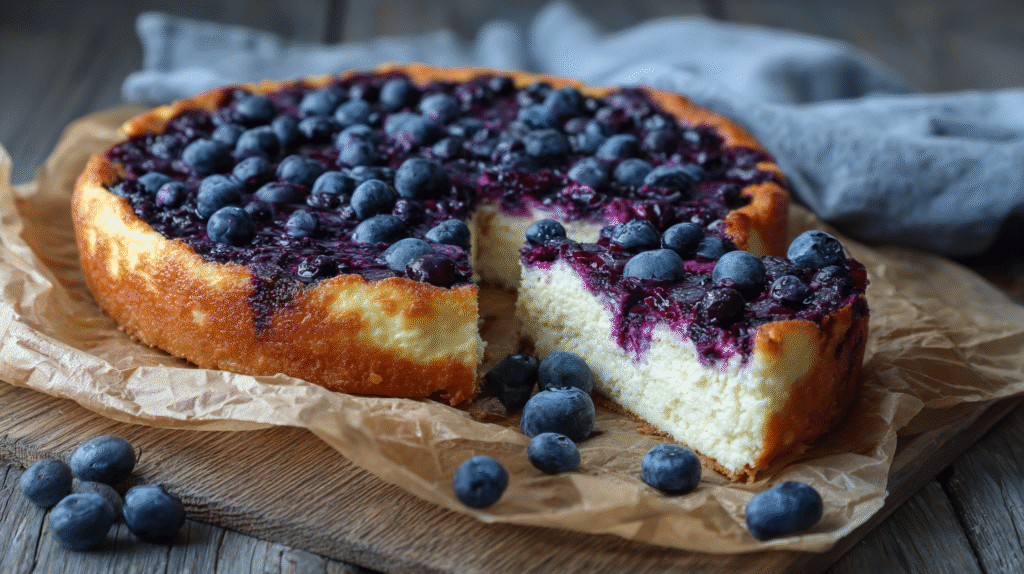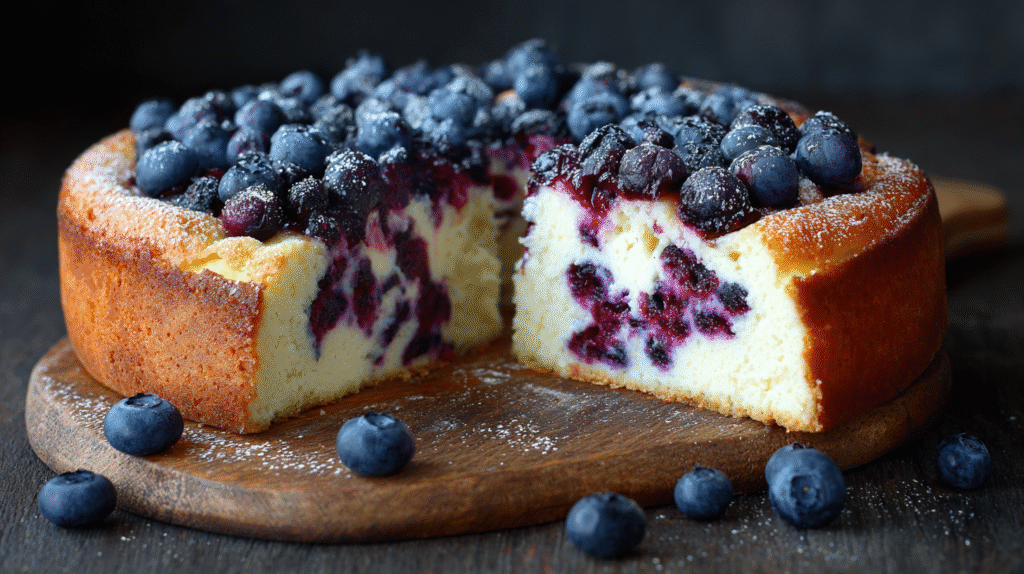Let me guess—you’re craving something sweet, creamy, and indulgent, but you don’t want to derail your low-carb lifestyle. I’ve been there countless times, staring into the fridge wondering if I could make a cheesecake that won’t spike my blood sugar or leave me feeling guilty.
Here’s the good news: you absolutely can. This moist low-carb cheesecake with blueberries delivers all the creamy, decadent satisfaction of traditional cheesecake without the carb overload. I’m talking about a dessert that’s so rich and flavorful, your non-keto friends won’t even notice it’s low-carb.

Why This Low-Carb Cheesecake Actually Works
Most low-carb desserts fail because they’re either dry, tasteless, or have that weird aftertaste that screams “sugar substitute.” This recipe sidesteps all those issues.
The secret is in the moisture content. By using full-fat cream cheese and adding sour cream to the batter, you create a texture that’s impossibly smooth and creamy. The blueberries add natural sweetness and a pop of tartness that cuts through the richness perfectly.
And before you ask—yes, it’s genuinely low in carbs. We’re talking about 5-7 grams of net carbs per slice, depending on how you cut it.
The Best Sweeteners for Low-Carb Cheesecake
This is where most recipes go wrong. Not all sugar substitutes behave the same way in baking.
Erythritol is my top choice here. It measures cup-for-cup like sugar, doesn’t have a bitter aftertaste, and won’t cause digestive issues for most people. The powdered version works even better because it dissolves completely into the batter.
Allulose is another excellent option. It browns and caramelizes like real sugar, which is rare for sugar alcohols. The texture it creates is closer to traditional cheesecake than any other sweetener I’ve tested.
Avoid stevia on its own—it’s too concentrated and can leave a metallic taste. If you use it, blend it with erythritol for better results.
Creating the Perfect Almond Flour Crust
The crust makes or breaks a cheesecake. Traditional graham cracker crusts are loaded with carbs, but an almond flour crust can be even better when done right.
Start with finely ground almond flour, not almond meal. The finer texture creates a more cohesive crust that holds together without crumbling. Mix it with melted butter and a touch of sweetener, then press it firmly into your pan.
Here’s a trick most recipes don’t mention: pre-bake your crust for 10 minutes at 350°F before adding the filling. This prevents it from getting soggy and gives it that perfect golden-brown color and slightly nutty flavor.
For extra stability, I sometimes add a tablespoon of coconut flour to the almond flour mixture. It absorbs excess moisture and helps the crust bind better.
Getting That Perfectly Moist Texture Every Time
Dry, cracked cheesecake is the enemy. Here’s how to avoid it completely.
First, all your ingredients need to be at room temperature. Cold cream cheese creates lumps, and those lumps mean you’ll overmix trying to smooth them out. Overmixing incorporates too much air, which leads to cracks.
Second, use the water bath method. Place your springform pan inside a larger roasting pan and fill the outer pan with hot water about halfway up the sides. This creates a humid environment that keeps the cheesecake moist and prevents the top from drying out.
Bake at a lower temperature—around 325°F—and don’t rush it. The center should still have a slight jiggle when you take it out. It will firm up as it cools.
The final trick: let it cool gradually. Turn off the oven, crack the door open, and let the cheesecake sit for an hour before removing it. This prevents thermal shock that causes cracks.
Why Blueberries Are the Perfect Low-Carb Fruit Choice
Not all berries are created equal when you’re watching your carbs. Blueberries sit in the sweet spot—literally.
They contain about 11 grams of net carbs per half cup, which is moderate compared to other fruits. But their natural sweetness means you don’t need to add extra sweetener to make them taste good.
More importantly, blueberries are packed with antioxidants, particularly anthocyanins, which give them their deep blue color. These compounds have been shown to support heart health and reduce inflammation.
Fresh blueberries work beautifully swirled into the batter or scattered on top. If you’re using frozen ones, don’t thaw them first—add them frozen to prevent them from turning your cheesecake purple.
Recipe for Low-Carb Cheesecake With Blueberries
Let me walk you through exactly how to make this cheesecake. I’ve tested this recipe probably a dozen times to get it right.
For the crust:
- 2 cups almond flour
- 1/4 cup powdered erythritol
- 6 tablespoons melted butter
- 1/2 teaspoon vanilla extract
For the filling:
- 24 oz cream cheese (full-fat, room temperature)
- 3/4 cup powdered erythritol
- 3 large eggs (room temperature)
- 1 cup sour cream
- 1 tablespoon lemon juice
- 1 teaspoon vanilla extract
- 1 cup fresh blueberries
Mix your crust ingredients until they resemble wet sand. Press firmly into a 9-inch springform pan and pre-bake. While that’s cooling, beat the cream cheese and sweetener until fluffy—about 3 minutes.
Add eggs one at a time, mixing on low speed just until incorporated. Fold in sour cream, lemon juice, and vanilla. Don’t overmix here.
Gently fold in half the blueberries. Pour into the crust, top with remaining blueberries, and bake in a water bath at 325°F for 55-65 minutes.

Common Mistakes That Ruin Low-Carb Cheesecakes
I’ve made every mistake possible with this recipe, so you don’t have to.
Mistake #1: Using low-fat cream cheese. Don’t do it. The fat is what makes the cheesecake creamy and moist. Low-fat versions will give you a dry, rubbery texture.
Mistake #2: Opening the oven door repeatedly. Every time you do this, the temperature drops and you risk cracks. Check it once near the end of baking time, that’s it.
Mistake #3: Cutting it too soon. I know it’s tempting, but warm cheesecake is messy and won’t slice cleanly. Refrigerate it for at least 4 hours, preferably overnight.
Mistake #4: Not using parchment paper in your springform pan. This makes removal so much easier and prevents sticking.
How to Store and Serve Your Cheesecake
This cheesecake actually tastes better after a day in the fridge. The flavors meld together and the texture becomes even more velvety.
Store it covered in the refrigerator for up to 5 days. If you want to freeze it, wrap individual slices tightly in plastic wrap, then aluminum foil. They’ll keep for up to 3 months.
For serving, let slices sit at room temperature for about 10 minutes. This takes the chill off and makes the texture even creamier. A dollop of sugar-free whipped cream on top is optional but highly recommended.
Nutritional Benefits Beyond Just Low Carbs
This isn’t just about cutting carbs—this cheesecake actually offers some nutritional value.
The cream cheese and eggs provide a solid dose of protein, about 8-10 grams per slice. That protein helps keep you satisfied and stabilizes your blood sugar better than a carb-heavy dessert would.
Almond flour brings healthy fats and vitamin E to the table. These monounsaturated fats support heart health and help your body absorb fat-soluble vitamins.
The blueberries contribute fiber, vitamin C, and those powerful antioxidants I mentioned earlier. You’re not just avoiding carbs—you’re actually nourishing your body.
Troubleshooting Your Cheesecake Issues
Let’s address the problems you might run into.
If your cheesecake cracks: It’s likely overcooked or cooled too quickly. Use the water bath method and gradual cooling technique I described earlier.
If it’s too dense: You probably overmixed the batter after adding the eggs. Mix just until combined, no more.
If the crust is soggy: Pre-bake it longer, or add that tablespoon of coconut flour I mentioned to absorb excess moisture.
If it tastes too “eggy”: Add an extra teaspoon of vanilla extract and make sure you’re using fresh eggs. Old eggs can give an off flavor.
Variations to Keep Things Interesting
Once you’ve mastered the basic recipe, there are endless ways to mix it up.
Swap blueberries for raspberries or blackberries. Both are slightly lower in carbs and offer different flavor profiles. Strawberries work too, though they’re a bit higher in sugar.
Add a sugar-free chocolate ganache topping by melting dark chocolate (85% cacao or higher) with heavy cream. Pour it over the cooled cheesecake for an extra layer of indulgence.
Try a swirl of sugar-free caramel or a layer of lemon curd made with low-carb sweeteners. The tanginess pairs beautifully with the creamy cheesecake base.
For a flavor twist, add a teaspoon of almond extract to the filling or mix in some orange zest for a subtle citrus note.
Frequently Asked Questions
Can I make this cheesecake dairy-free?
Yes, but the texture will change. Use coconut cream instead of cream cheese and coconut cream in place of sour cream. The result will be lighter and less tangy, but still delicious.
How many net carbs are in each slice?
A standard slice (1/12 of the cheesecake) contains approximately 5-7 grams of net carbs, depending on the sweetener you use and how generously you add blueberries.
Will this cheesecake work without the water bath?
It can work, but you’re more likely to get cracks and a drier texture. If you skip the water bath, reduce the oven temperature to 300°F and bake for a slightly shorter time.
Can I use a different type of flour for the crust?
Coconut flour won’t work well as a direct substitute—it’s too absorbent. Ground pecans or walnuts make excellent alternatives to almond flour for a different nutty flavor.
How do I know when the cheesecake is done?
The edges should be set and slightly puffed, while the center should still jiggle like Jell-O when you gently shake the pan. An instant-read thermometer should read 150°F in the center.
Can I make mini cheesecakes instead of one large one?
Absolutely. Use a muffin tin lined with cupcake papers. Reduce the baking time to 18-22 minutes. Mini cheesecakes are perfect for portion control.
What’s the best way to slice cheesecake cleanly?
Use a sharp knife dipped in hot water and wiped clean between each cut. This prevents the filling from sticking to the blade and gives you clean, professional-looking slices.
Final Thoughts
Making a moist low-carb cheesecake with blueberries isn’t complicated, but it does require attention to detail. The techniques I’ve shared here—room temperature ingredients, the water bath method, gradual cooling—make the difference between an okay dessert and an exceptional one.
This cheesecake proves that low-carb eating doesn’t mean deprivation. You can enjoy rich, satisfying desserts that align with your health goals. The combination of creamy texture, natural sweetness from blueberries, and that perfectly crispy almond crust creates something special.
Give this recipe a try. Take your time with it. And when you pull that perfectly smooth, crack-free cheesecake from the oven, you’ll understand why it’s become my go-to dessert for everything from weeknight treats to special occasions.
